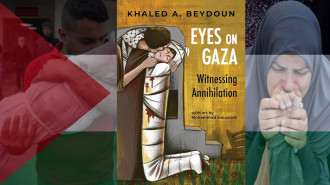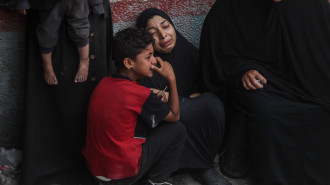
Kidnapped, killed, and bodies left rotting in the streets: Israel targets Gazans trying to return home

Unarmed and defenceless civilians are being stalked and murdered by Israeli drones as they attempt to reach their homes in Gaza's Rafah to fetch basics like blankets and clothes. These essential items are much-needed in the gruelling lives of those forcibly displaced by Israel, as they live in tents or on the streets in an attempt to avoid Israel's relentless bombardment.
Those attempting to make the journey are disappearing without a trace, with many families waiting until now for news of their loved ones who went out and never returned. Others are being killed with their slaughtered bodies left to decompose in the ruined streets of their neighbourhoods.
"Suleiman's wife decided to return to the family home to fetch the essential items, thinking Israeli forces wouldn't fire on women and children"
Suleiman Al-Arja and two of his brothers risked their lives to bring back the bodies of Suleiman's wife, sister and two daughters, after they were killed in the Al-Tannour neighbourhood in eastern Rafah City on September 2.
They had been trying to reach their house to gather clothes, shoes and blankets for family members displaced in the al-Mawasi area in Khan Younis.
The family desperately needed these items, and after more than four months of living in tents, Suleiman's wife decided to return to the family home to fetch them, thinking the Israeli forces wouldn't fire on women and children.
Suleiman's wife, his sister and two daughters set off back to their neighbourhood, holding up a white flag and walking in the middle of the streets to be clearly visible. Suleiman was on the phone with them the whole time, until suddenly he heard a loud whistling sound and the line cut.
He learned afterwards they had been targeted by a missile from an Israeli drone, which killed them in the middle of the neighbourhood.
The family sought help retrieving the bodies, but none of the relief agencies would go due to the risk, so the corpses of his family were left in the street for over 20 hours. Eventually, Suleiman and his brothers managed to go there and gather the body parts themselves.
As they made their way, they saw bodies rotting in the streets of the neighbourhood, all of which looked like they had been targeted in the same way.
Hunting returnees
The Palestinian Civil Defence has received over 500 notices of citizens who entered Rafah to search their homes and haven't been seen since.
The Civil Defence has been able to retrieve the bodies of 270 people killed since July 1, according to Dr Mohammed al-Mugheir, the head of the department of supplies at the Gaza Civil Defence.
He explained to Al-Araby Al-Jadeed, The New Arab's Arabic-language sister edition that although Israel had classified eastern Rafah as a "dangerous combat zone," its forces were killing civilians across the governorate using drones fitted with missiles and machine guns.
Ismail Al-Thawabta, the director of the Gaza government media office, said the killings were being documented in areas empty of tanks, which weren't classified as dangerous combat zones, indicating that the killing of civilians was deliberate, unjustified and being carried out in defiance of any international or humanitarian laws.
The Israeli army has even published videos showing its planes targeting unarmed civilians, he added, and after these cases have been analysed and follow-up data gathered, it has been clear that those killed were either returning to or from their homes.
Mahmoud Yassin, 20, was almost killed after trying to return to his home in Rafah city's Shaboura camp. He had set off with two neighbours taking the Mouraj road. At one point he became aware of a reconnaissance aircraft hovering above them, and he drew back, falling behind his companions. Seconds later, they were targeted by an airstrike, killing both his companions instantly.
Mahmoud fled, seeking refuge in the ruins of a nearby bombed-out building where he hid until the sound of the aircraft had gone. At this point he came out and headed towards his friends to try to retrieve their bodies, but was attacked by another drone, the blast just missing him but shrapnel tearing through his hand. He ran towards some demolished houses and hid for over two hours, before moving from place to place until he managed to exit the area.
'They went out and never came back'
Among those missing in Rafah is Ahmad Subaihi. The father, in his forties, had headed to his house to get things his children needed. He then disappeared without a trace.
His friend Hazem Khalil says the last anyone saw of Ahmad was him entering the Al-Tannour neighbourhood. His brothers went looking for him the next day, entering the area despite the risks. However, they looked everywhere but didn't find him.
The family went to multiple organisations, including the Red Cross and the Civil Defence to tell them about Ahmad's disappearance, but no one has been able to tell them anything until now.
"Israeli army personnel are disguising themselves as members of the Civil Defence, driving ambulances and even hiding in civilian homes, emerging to arrest passersby in the streets"
Their story is far from unique – Gazans' social media is flooded with posts by those who have lost sons, brothers, or other relatives inside Rafah, appealing to anyone who can help find them.
Among them is the family of Abdul-Rahman Issa, from the Tel Sultan neighbourhood in western Rafah, who post photos of him daily as they repeatedly make appeals for any information on his fate or whereabouts.
An informed security source (who wished to remain anonymous to avoid being targeted) believes there are several possibilities; they could have been targeted by drones and their bodies left in the streets or were retrieved later on, they could have been arrested, transferred to interrogation centres and detained inside Israel. The source further explained how Israeli army personnel are disguising themselves as members of the Civil Defence, driving ambulances and even hiding in civilian homes, emerging to arrest passersby in the streets.
The third scenario was that they were killed, and their bodies stolen and taken inside Israel, to be returned after they had decomposed to unrecognisable remains. The source explains that this has happened around a dozen times, in which over 500 corpses had been returned, all of them in an advanced state of decay rendering them unidentifiable.
A fourth possibility was that they were killed and buried in mass graves in unknown locations – numerous cases like this had been discovered at the Al-Shifa and Al Nasser hospitals, and other areas of Khan Younis.
The fifth scenario was that Gazans were being kidnapped and used as human shields during raids of homes and tunnels. The source says civilians have been used in this way and sent to dismantle explosive devices and objects believed to have been planted by resistance fighters.
Mugheir confirms this, adding that the Civil Defence has evidence Israel had used 200 civilians arrested inside Rafah as human shields. Some of them were subject to field executions afterwards, while others were arrested, their fates still unknown.
Dr Fadel al-Muzaini, the Director of the Palestinian Centre for Human Rights' Economic and Social Rights Unit, said Israel's total disregard for all international calls to halt its genocidal crimes in Gaza is the result of the immunity provided by the Western countries — as well as their direct complicity — which has established a policy of impunity.
This is an edited and abridged translation from our Arabic edition. To read the original article click here.
Translated by Rose Chacko
This article is taken from our Arabic sister publication, Al-Araby Al Jadeed and mirrors the source's original editorial guidelines and reporting policies. Any requests for correction or comment will be forwarded to the original authors and editors
Have questions or comments? Email us at: info@alaraby.co.uk




 Follow the Middle East's top stories in English at The New Arab on Google News
Follow the Middle East's top stories in English at The New Arab on Google News


